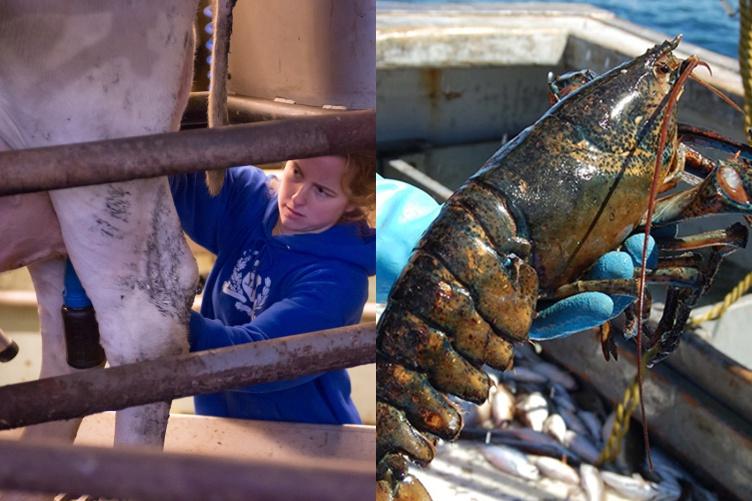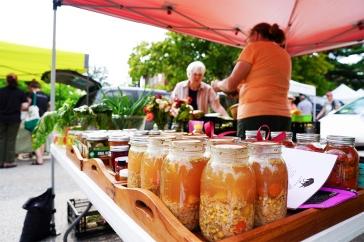
About the Supplemental Nutrition Assistance Program (SNAP):
The U.S. Department of Agriculture (USDA) oversees 15 domestic food and nutrition assistance programs, impacting millions of individuals and constituting approximately two-thirds of the USDA's annual budget.
In FY 2022:
- The combined expenditure for these programs reached $183.0 billion.
- SNAP accounted for approximately 65% of that spending.
- On average, 41.2 million people participated in SNAP each month (about 12% of the total U.S. population, or 1 in 8 people in the U.S.).
According to the U.S. Census Bureau:
- The median income of households receiving SNAP is about $25K.
- Of households receiving SNAP, 48.6 percent have children under 18 years of age.
SNAP Funding: Read more
SNAP Economic Benefits: Read more
SNAP & SNAP-Ed in New Hampshire:
In New Hampshire, more than 70,000 residents—about 5.1 percent of the population—participate in SNAP. However, many more around the state could participate, especially considering changes made earlier this year to the program setting the eligibility threshold for SNAP, as well as the educational portion of SNAP (known as SNAP-Ed), at 200 percent of the federal poverty level, explained Amy Hollar, an associate state specialist with UNH Extension. Read more
“New Hampshire ranks pretty low as far as the number of SNAP participants based on its eligible population,” said Hollar. “It has one of the lower participation rates in the country for this federally funded program, so we’re working on getting the word out as much as possible about the new eligibility threshold for SNAP.”
The federally funded Supplemental Nutrition Assistance Program (SNAP) is a lifeline to more than 70,000 Granite Staters—about 5.1 percent of the population—enabling access to nutrition education, fresh food and, ultimately, improved health and well-being for some of the state’s most vulnerable communities. Despite these benefits, many eligible individuals do not participate—a vexing issue for organizations implementing the program and its overall public health effectiveness. Part of the challenge, identified by New Hampshire Agricultural Experiment Station (NHAES) scientist Sherman Bigornia, is the need for community educators and program administrators to tailor their efforts in ways that align with the values and needs of specific communities, rather than taking a one-size-fits-all approach. Bigornia’s research is investigating what that tailoring may entail.
"My first project with the NH Agricultural Station provided evidence that the current SNAP-Ed curriculum used by UNH Cooperative Extension may not be effective at improving dietary quality and chronic disease risk among Bhutanese refugee adults – a specific Granite State population,” said Bigornia, an assistant professor in the agriculture, nutrition, and food systems department at the UNH College of Life Sciences and Agriculture. The SNAP-Ed curriculum, though translated to Nepali, was not otherwise tailored to the Bhutanese refugee community.
“We learned that participants in our study were meeting recommendations for vegetables, added sugars, and saturated fat, but not for whole grains and fruits,” he added. In additional analyses, Bigornia and his colleagues found that those who reported more fruit and whole grain consumption had better inflammatory and lipid profiles, respectively.
“To me, this suggests that cultural tailoring may improve the impact of SNAP-Ed on the health of Bhutanese refugee adults by emphasizing fruits and the balance of whole and refined grain consumption, while paying less attention to dietary recommendations that they are already meeting,” Bigornia said.
NHAES scientist Sherman Bigornia's work with Granite State Bhutanese populations helped him identify the need for culturally tailored nutrition education. Produced for the THRIVE magazine Fall 2022 issue.
The broader implication of the research was that tailored nutritional plans considerate of peoples’ experiences and histories may help reduce the prevalence of chronic diseases, such as obesity and diabetes, he added.
Bigornia’s current NHAES research, conducted in collaboration with other Station scientists and outreach support from UNH Cooperative Extension state specialists, focuses on understanding what changes are needed to help promote the greater consumption of both seafood and dairy among New Hampshire adults. Recently, Bigornia’s lab reported that dairy fat consumption was associated with better cognitive functioning. By identifying some of the barriers that Granite Staters have to accessing local seafood and dairy products, this work could achieve the dual benefit of reducing the risk of age- and lifestyle-related health conditions for those New Hampshire residents that increase their seafood and dairy intakes, and increasing demand for local products from the state’s commercial dairy and seafood sectors, which provide an estimated $140 million and $90 million, respectively, in annual economic output.
Bigornia is also leading a related research project through New Hampshire Sea Grant, which focuses on developing a culturally tailored online nutrition education program to increase fish consumption among low-income Latino adults in the Granite State—a program based on the evidence of the potential health benefits, particularly for brain health, of consuming fish. Previous work by Bigornia and his colleagues has shown that Latino adults who reported consuming more omega-3 fatty acids—nutrients that have high concentrations in fish—tended to have better cognitive functioning and lower depressive symptoms over time.
“This research is still in the early stages however, it will ultimately inform the tailoring of dietary and health messaging targeting greater seafood and dairy consumption among Granite Staters,” said Bigornia.
Why Consuming Seafood Is Good for SNAP-Ed...and for Business
“Ultimately, this research will provide key insight to harvesters, producers and consumers about the importance of not only eating seafood, but also for providing a greater variety of species—and at different price points—to New Hampshire and New England consumers.” ~ Gabriela Bradt, associate state specialist, UNH Cooperative Extension and NH Sea Grant
While much of SNAP-Ed programming concentrates on fruit and vegetable consumption, evidence suggests that fish consumption is associated with lower risk of dementia and depression, according to Bigornia, adding that both conditions are disproportionately experienced by Latino adults in the U.S. Furthermore, national data indicates that Latino adults consume less than half the recommended 8-ounce-per-week serving of fish recommended by the American Heart Association.
“So, supporting fish consumption in particular among Granite Staters—especially those from Latin American countries—may improve overall health outcomes,” he added. “Moreover, the New England region has experienced the slowest growth in seafood sales between 2016 and 2021, at 26 percent, whereas the national average was 41 percent for the same period.”
In New Hampshire, there are several factors contributing to the slow growth of seafood sales, with one of the biggest components being the high price of seafood that makes these foods inaccessible to individuals within lower income brackets, explained Gabriela Bradt, an associate state specialist with UNH Extension and NH Sea Grant.
Another component is that American consumers are notoriously picky seafood eaters, often limiting themselves to five species, Bradt added. In 2021, the top five consumed fish species in the U.S. were shrimp, salmon, canned tuna, tilapia (freshwater) and Alaskan pollock. Lobster—a New England staple and the largest fishery in Maine and New Hampshire—doesn’t even make the top ten species consumed by Americans. The research led by Bigornia could lead to not only more effective ways to educate New Hampshire’s SNAP recipients to consume seafood products that benefit their health and well-being, but to also empower those same consumers to seek seafood that is locally sourced from New Hampshire and New England producers—rather than only the top five species—thus growing the state’s and region’s seafood industries.
“Ultimately, this research will provide key insight to harvesters, producers and consumers about the importance of not only eating seafood, but also for providing a greater variety of species—and at different price points—to New Hampshire and New England consumers,” said Bradt, who will help distribute the findings of this research once complete.
Interested in reading more about this research? Sign up to receive a printed version of the upcoming INSPIRED Research Report: Food Markets, Nutrition and Community Dynamics—due out this fall!
Bigornia's work is supported by the NH Agricultural Experiment Station through joint funding from the USDA National Institute of Food and Agriculture (under Hatch award number 1020097) and the state of New Hampshire, and by a grant from New Hampshire Sea Grant. You can learn more Bigornia’s research on his lab website.
-
Written By:
Nicholas Gosling '06 | COLSA/NH Agricultural Experiment Station | nicholas.gosling@ngskmc-eis.net
















































